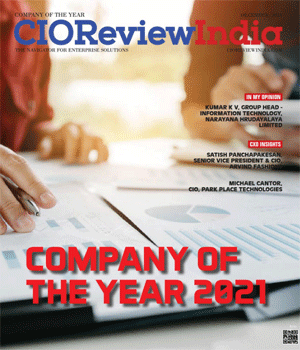
How IoT Analytics and Strategy Boosts Manufacturing?
Geetika Tripathi, Senior Quality Specialist P&I Technology Engineering Services, SAP Labs India | Friday, 13 January 2017, 09:05 IST
 After witnessing three industrial transformations kindled by steam power, electricity and IT Technology, the world is all set to usher in the fourth transformation, known as Industry 4.0. Industry 4.0 will blends together computers and automation i.e. cyber-physical systems, and the Internet of Things (IoT) clubbed along with data and services to reshape manufacturing industry as we know it, thus giving rise to ‘Smart Factories’ in the near future.
After witnessing three industrial transformations kindled by steam power, electricity and IT Technology, the world is all set to usher in the fourth transformation, known as Industry 4.0. Industry 4.0 will blends together computers and automation i.e. cyber-physical systems, and the Internet of Things (IoT) clubbed along with data and services to reshape manufacturing industry as we know it, thus giving rise to ‘Smart Factories’ in the near future.
We are entering the era of Internet of things, wherein cyber-physical systems seamlessly interact with the web in unimaginable ways without human intervention on real time. Industry 4.0 depends on Internet of things (gadgets, machines which can communicate and help us interact) and will need a lot of data for input.
Machines talking to each other, discovering and analyzing issues within products in advance, automation of assembly lines, and minimum human supervision. What is the ultimate outcome of this mammoth amount of data, information and complex processes spawned by various sensors, systems, machines and shop floors? The answer lies ahead.
The Significance of Big Data, IoT and Advanced Analytics
Clive Humby Co-founder of dunnhumby had accurately remarked that “Data is the New Oil”. We are in an age where data has become more precious than anything. In today’s Digital economy, Analytics is the magic baton which turns this crude data into the gasoline of consequential insights. The potential of large sets of data can only be realized when it generates significant actionable insights.
We create and improvise technologies to increase the efficiency of work for greater profitability at a lower cost. But how can advanced Big Data and IoT analytics bring a discernible value to the manufacturing table?
Simplifying complex data for increasing efficiency
Ease of access to important information plays a key role in the functioning of an organization. Internet of things (IoT) creates tremendous opportunities for organizations by decentralizing decisions. Data analytics helps process and analyze essential information useful for enterprises. To measure their pivotal performance indicators like productivity and quality, resulting in the end goal of reducing time, cost and increasing revenue. The composition of legitimate data is analytics which is extremely crucial and can be a game changer.
For e.g. A car manufacturing giant uses the analyzed information from climate sensors to deduce if the weather is optimal (nor too humid nor hot) for painting the automobile. This crucial data helps the company shift the work to another plant thus saving time and cost spent on equipment service. Internet of things (IoT) analytics aids in speedy delivery, optimized cost and augmented proceeds.
Renders valuable insights
Advanced analytics will enable manufacturing companies to improve the production quality by identifying issues and avoiding product failures. Running efficient algorithms on the vast overflowing data can enrich boardroom decisions with fresh insights.
Benefits of Analytics
In the future, companies will be required to adapt to new technologies and work towards an integrated system including real-time decision making, enhancing productivity, customer service and innovation for future products.
Some of the major tools in the analytics artillery are Predictive Methodologies, Prescriptive Analytics, Machine Learning, Forecasting models, Neural Networks and so on. Their usage has led to the unraveling of hidden patterns, correlations, trends and untapped insights.
Stepping into the future
The age of Big Data and IoT technology has clearly unfolded a new path and way of living. There are still some apprehensions. For instance, how can manufacturing industries adhere to this new concept? How will industries shed traditional practices and accept full-fledged modernistic approach? The fact is, the transition would not be so easy.
1. The first step would be to devise a robust cross-functional digital strategy. This translates to creating methods and ways to pan out value from volumes of big data. Identifying problems, roadblocks and creating innovative solutions by using in-house techniques are some of the key points to remember.
2. Companies have been using crowdsourcing, machine learning, data integration and advanced analytics as problem-solving methods. Making use of the evolving data to derive crucial information.
3. Securing data is one of the most important concerns for any organization. Using big data analytics technique to identify security breaches, securing organization and customer information is also essential.
The key to staying ahead of competition lies in informed and timely transformation.
CIO Viewpoint
How Can MSME Digitally Grow Business During...
By Srivaths Varadharajan
It's Time We Breakdown Our Data Security Fallacies
By Priyank Kothari, Head - Information Security, Tesco
The Right Side Of Digital Transformation
By Upinder Phanda, Vice President and CIO, Unisys Corporation
CXO Insights
By DR. Makarand Sawant, Senior General Manager IT, Deepak Fertilizers and Petrochemicals Corporation Limited
The State Of Customized Lending
By Sean Hunter, Chief Information Officer at OakNorth
10 Common Types Of Malware And How To Combat...












